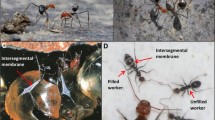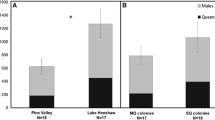Abstract
In the primitively eusocial wasp, Ropalidia marginata, low levels of intra-colony genetic relatedness, lack of intra-colony kin discrimination and acceptance of young wasps into alien colonies, prompted us to investigate whether or not there exists a cost of such high genetic variability. Freshly eclosed wasps were paired either with their nestmates or with their non nestmates and their performance in nest building and brood care were compared. There was no demonstrable difference between nestmate and non nestmate pairs in terms of success in raising adult offspring, time required for nest initiation, brood developmental period and productivity. There was also no difference in the efficiency of cooperation and division of labour between the nestmate pairs and non nestmate pairs. These results reinforce the idea that the haplodiploidy hypothesis is insufficient to explain the prevalence of worker behaviour in R. marginata and emphasize the importance of factors other than genetic relatedness in the evolution of eusociality.
Similar content being viewed by others
Author information
Authors and Affiliations
Additional information
Received: 27 April 1998 / Accepted: 10 July 1998
Rights and permissions
About this article
Cite this article
Arathi, H., Gadagkar, R. Cooperative nest building and brood care by nestmates and non nestmates in Ropalidia marginata : implications for the evolution of eusociality. Oecologia 117, 295–299 (1998). https://doi.org/10.1007/s004420050661
Issue Date:
DOI: https://doi.org/10.1007/s004420050661




